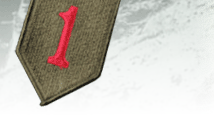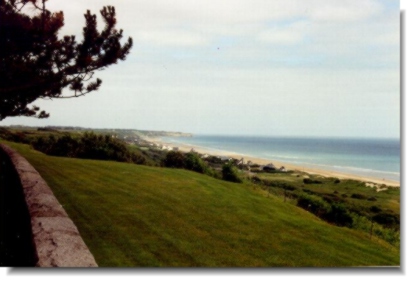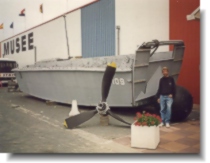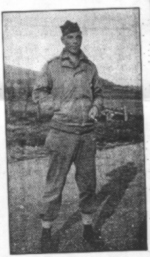Mike McKinney 16th Reg. Co. L. 1st Div. First ones in on Omaha.EAST SECTOR OF OMAHA BEACH, THE COLLEVILLE AREAWe left Weymouth shortly after sundown on June the fifth. The Channel is only twenty miles long, so the crossing was not such a big deal. We were twelve miles of the coast of Normandy when we transferred from the troopship onto the landingcraft. The coxswain circled the boat around the ship once the boat was filled and when all the boats were filled we got the signal to head for the shore. We had 32 guys on board of our boat, that was one section. everybody was crouched down, which was not very comfortable.
It was clouded and daylight had already come up when we hit the beach. Our boat was hit twice by shrapnel or machine-gunfire while our boat approached the beach. The coxswain was the only-one looking out. He was on the back of the boat and he just kept going. We were the first wave so if we had looked out there wouldn't have been much to see. The boats came in on the beach one after the other. My boat was the first one in line. The sea was choppy. Colonel Sohutsky's boat was nr. four and therefore behind us. His boat was swamped by the rough sea and all the men in his boat drowned. We of coarse didn't knew that then, but we heard it later in the day.
Beyond the Beachhead: The 29th Infantry Division in Normandy (Stackpole Military History Series)
Joseph Balkoski
American Iliad: The History of the 18th Infantry Regiment in World War II
Robert W. Baumer
We were carrying a special assault jacket, with quick release snaps in front. Underneath the torpedo's I had the life-preserver. I was ready to inflate the life-preserver and snap the releases to get rid of all the stuff when I realized that I would be able to take it all with me to shore. I just started running and thought off nothing else. There were Jumping-jack's and some of the guys stopped there. They didn't dare to go forward. I figured that the safest place would be where the hill came down and hit the beach. I had started running when I had reached shallow water and I kept going as fast as all the equipment permitted. Crossing the beach I saw strings of sand pop up: Machine-gunfire. I reached the foot of the hill and I don't remember anybody else being there right then. They started showing up soon. In five or ten more minutes, the other boats had landed as well and we were joined by a lot more men. We were all laying at the foot of the hill, behind a shelter of maybe a foot high. Not much cover of coarse. When I looked up over the shelter I could look right into the slit of the pillbox. As far as I was concerned we had landed on the exact right spot. I told Al White, my second in command what we would do to organize things when all of a sudden he took a bullet in the head and laid down next to me. He had been with me since the States, but I had no time to grieve on this. The organization had to be kept going.
I got a man to push the bangalore torpedo's under the barb wire, like we had trained. These torpedo's were long pipes filled with dynamite. Two engineers went forward and screwed the pipes together, so they could be pushed one after another further and further under the barb wire. The Germans weren't ready to give up yet, so they threw hand-grenades from the pillbox to the engineers. We had to get more men up there to throw these grenades away. (this had not been practiced!) A cap was placed in the last bangalore. The engineer pulled the cap and ran back while the whole thing blew. When the wire was blown, the flame-thrower was send up. This was a two-man unit. One was carrying the tanks and the other carried the nozzle and would direct the flames. They made the Germans close the slits in the pillbox. This gave another the opportunity to go around the pillbox and set the sasule-charges. These charges blew up the backdoor and then the flame-thrower went in to burn the inside of the pillbox.
When we had entered the pillbox, we took a five minutes break. We didn't have a radio, so we had to send someone back to company headquarters, to inform them that the beach-exit was secured and safe. I found a can of fish and I sat down in the pillbox and ate it. After that I went on with souvenir-hunting in the pillbox and I found a little holy picture made of wood and a cigarette-case. Other troops started passing through our lines by then and we first stayed behind. Before we joined the other troops in their advance inland I looked back on the Channel and saw all these ships just of the coast. All these little balloons were tagged to them. You could still see the battleships shooting. You could hear the shells coming over our heads. Our day ended a bit further inland. We didn't reached Colleville that first day. We would do that the next day. |

 I think everybody was really quiet once we were in the landingcraft. I think we realized that this was a pretty momentous moment. This was definitely going to be the last landing. When we hit the beach we would be in Europe and we would not leave before the war was over. On all the occasions that I had been on a landingcraft, if
it was in the States, Tunisia or Sicily, I never once got sick. This time in the English Channel I did got sick. I wasn't more nervous than on the other landings, you become kind of a fatalist when you have been in combat for a long time. It was in that aspect just another landing. I had my share of near misses before we went into Normandy. We knew what artillery sounded like, so were didn't got scared by every sound that went over our heads. We knew the difference between shells coming in and going out.
I think everybody was really quiet once we were in the landingcraft. I think we realized that this was a pretty momentous moment. This was definitely going to be the last landing. When we hit the beach we would be in Europe and we would not leave before the war was over. On all the occasions that I had been on a landingcraft, if
it was in the States, Tunisia or Sicily, I never once got sick. This time in the English Channel I did got sick. I wasn't more nervous than on the other landings, you become kind of a fatalist when you have been in combat for a long time. It was in that aspect just another landing. I had my share of near misses before we went into Normandy. We knew what artillery sounded like, so were didn't got scared by every sound that went over our heads. We knew the difference between shells coming in and going out.
 All of a sudden the boat was grinning on to the sand and the ramp went down. Everybody started running out immediately. Our lieutenant was up at front while I myself was in the back of the craft. Machine-gunfire came into the boat and the guys
in the front were killed. I was the last one to get out of the boat and I had to get over the side to get away from the gunfire. I was carrying eighty pounds of equipment on my back, with bangalore torpedo's around my neck. The water came up to my neck, so I was pleasantly surprised to find my feet touching the sand.
All of a sudden the boat was grinning on to the sand and the ramp went down. Everybody started running out immediately. Our lieutenant was up at front while I myself was in the back of the craft. Machine-gunfire came into the boat and the guys
in the front were killed. I was the last one to get out of the boat and I had to get over the side to get away from the gunfire. I was carrying eighty pounds of equipment on my back, with bangalore torpedo's around my neck. The water came up to my neck, so I was pleasantly surprised to find my feet touching the sand.
 First thing that we had to do now was to get a line of fire laid down. A group of men had to go down to the waterline, with the light machine-gun that we had and open fire on the pillbox, so the Germans would keep their heads down. I ran around the men to get them organized. We had lost a lot of men coming down from the sea to the top of the beach, so these gaps had to be filled with other men. There was a bunch of guys from the 116th Regiment (29th Div.) that had apparently landed in the wrong area and they were very confused. I told them not to worry, stay here and we will put you to work.
First thing that we had to do now was to get a line of fire laid down. A group of men had to go down to the waterline, with the light machine-gun that we had and open fire on the pillbox, so the Germans would keep their heads down. I ran around the men to get them organized. We had lost a lot of men coming down from the sea to the top of the beach, so these gaps had to be filled with other men. There was a bunch of guys from the 116th Regiment (29th Div.) that had apparently landed in the wrong area and they were very confused. I told them not to worry, stay here and we will put you to work.
 Most of the Germans had already left their position when we send in the flame-thrower. There was a trench behind the pillbox, that led to a patch of wood further inland. The Germans that we didn't kill right away made it to those woods through the trench. By the time we had take the pillbox, it was late morning. All this time there had been no chaos or confusion on this part of the beach. We had trained this operation for six months, we were seasoned veterans and we ran through the whole process just like we had trained.
Most of the Germans had already left their position when we send in the flame-thrower. There was a trench behind the pillbox, that led to a patch of wood further inland. The Germans that we didn't kill right away made it to those woods through the trench. By the time we had take the pillbox, it was late morning. All this time there had been no chaos or confusion on this part of the beach. We had trained this operation for six months, we were seasoned veterans and we ran through the whole process just like we had trained.
 Mike McKinney received the Silver Star for his actions on Omaha Beach on D-day. The Star was rewarded for his brave actions in organizing the attack on the pillbox, going up and down the beach with disregard for his own safety.
Mike McKinney received the Silver Star for his actions on Omaha Beach on D-day. The Star was rewarded for his brave actions in organizing the attack on the pillbox, going up and down the beach with disregard for his own safety.